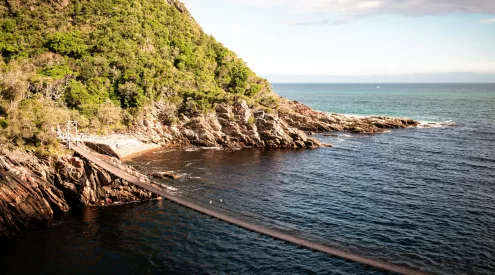The Cederberg Wilderness area covers an impressive 71,000 hectares of terrain – a rugged escape only two hour’s drive from Cape Town. For decades hikers, rock-climbers and outdoor enthusiasts have been enjoying time in this mountainous playground. Here’s a look at where to stay, what to do and the tree from which the area derives its name.
Where to Stay
1. Kliphuis campsite

On the Northern border of the Cederberg you’ll find the three Kliphuis Cottages. Each of these recently refurbished cottages have three bedrooms, sleeping up to six people.
There’s a fridge and gas stove, but no plug points so be sure to charge your devices before the trip. This is of course, the perfect place for a little digital detox. As the sun sets prepare for a light show as the already orange-shaded mountains turn deep red. One of the best places to observe from is the outdoor fireplaces in front of each cabin. Wood is conveniently available from reception during office hours.
The cottages are only a 3-minute drive from the Rocklands bouldering site, a favourite location for rock climbers. Explore a little further and you’ll find Wupperthal, a historic mission station, about a 45-minute drive away (if your vehicle has off-road ability).
2. Algeria campsite
 After driving past this well-known campsite periodically for year I was finally able to pay it a visit. The accommodation options are campsites or cottages and we chose one of the latter to relax in after our daily adventures. They’re spacious two-bedroomed units that offer generous mountain views from the stoep. There is also a private pool area for the exclusive use of cottage guests.
After driving past this well-known campsite periodically for year I was finally able to pay it a visit. The accommodation options are campsites or cottages and we chose one of the latter to relax in after our daily adventures. They’re spacious two-bedroomed units that offer generous mountain views from the stoep. There is also a private pool area for the exclusive use of cottage guests.
There are several hiking trails from Algeria, my favorute is the Waterfall Hike. An almost two-hour walk up the mountain is rewarded with your arrival at a large waterfall hidden in the kloofs. The views down the valley are simply breath-taking. Pack some lunch and enjoy a decent break here.
For a longer adventure take the 40-minute drive to Cederberg Winery to try their wines grown at altitude – some farmed at an incredible 1036 meters above sea level. Another 15-minutes and you have the Stadsaal caves and Truitjieskraal which are well worth exploring.
Both these properties are part of CapeNature’s annual 40% Winter Stay special, so take advantage for an affordable nature escape. You can book for both online and remember that by supporting CapeNature you’re supporting their conservation efforts as custodians of the environment.
Where the Cederberg got its name
The Clanwilliam cedar tree, or widdringtonia cedarbergensis, is one of four cedar species found in South Africa and as you guessed from the name, is endemic to the Cederberg. This ancient tree is a remnant of the last ice age and despite surviving millennia, it’s a plant that is increasing at odds with the environment that it calls home. An estimated 1-2 million trees once graced the mountain range, but today as little as 15,000 remain.
The first threat to the cedar population was the deforestation by early settlers, who almost decimated the population, only leaving clusters out of reach in remote rocky outcrops. Unlike their fynbos neighbours these trees are not regenerated by fire and so more frequent fires, possibly due to climate change, have also had a devastating effect. The trees also take an astonishing 30 years until they germinate so regrowth is laboriously slow.
Thankfully the erstwhile conservation efforts that began in the late 1800s have been bolstered by recent efforts to restock the area. Conservation authority CapeNature, in partnership with Bushmans Kloof Wilderness Reserve, has a seed collection and planting programme aiming to repopulate 2,000 trees per year to the area.

Annual cedar tree planting ceremony.
I was privileged to participate in the annual cedar tree planting ceremony held at Heuningsvlei along with members of the media. Over 200 people gathered for the occasion, and the festivities included Rieldans, a community lunch, and of course, planting cedars.
If you’d like to take part in this annual event, keep an eye on the CapeNature and Bushmans Kloof Facebook pages for updates.
Words and images: Jared Ruttenberg




















